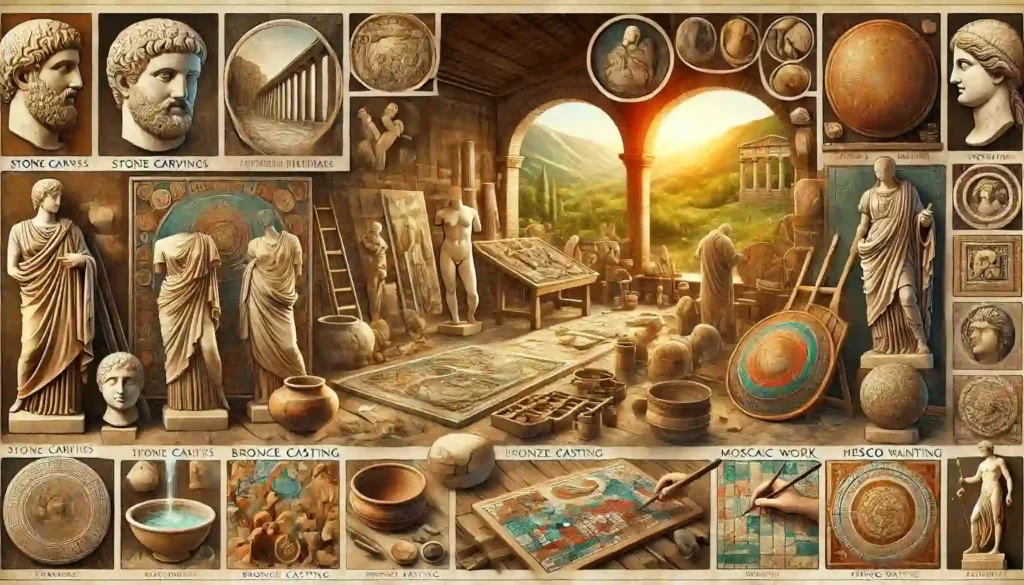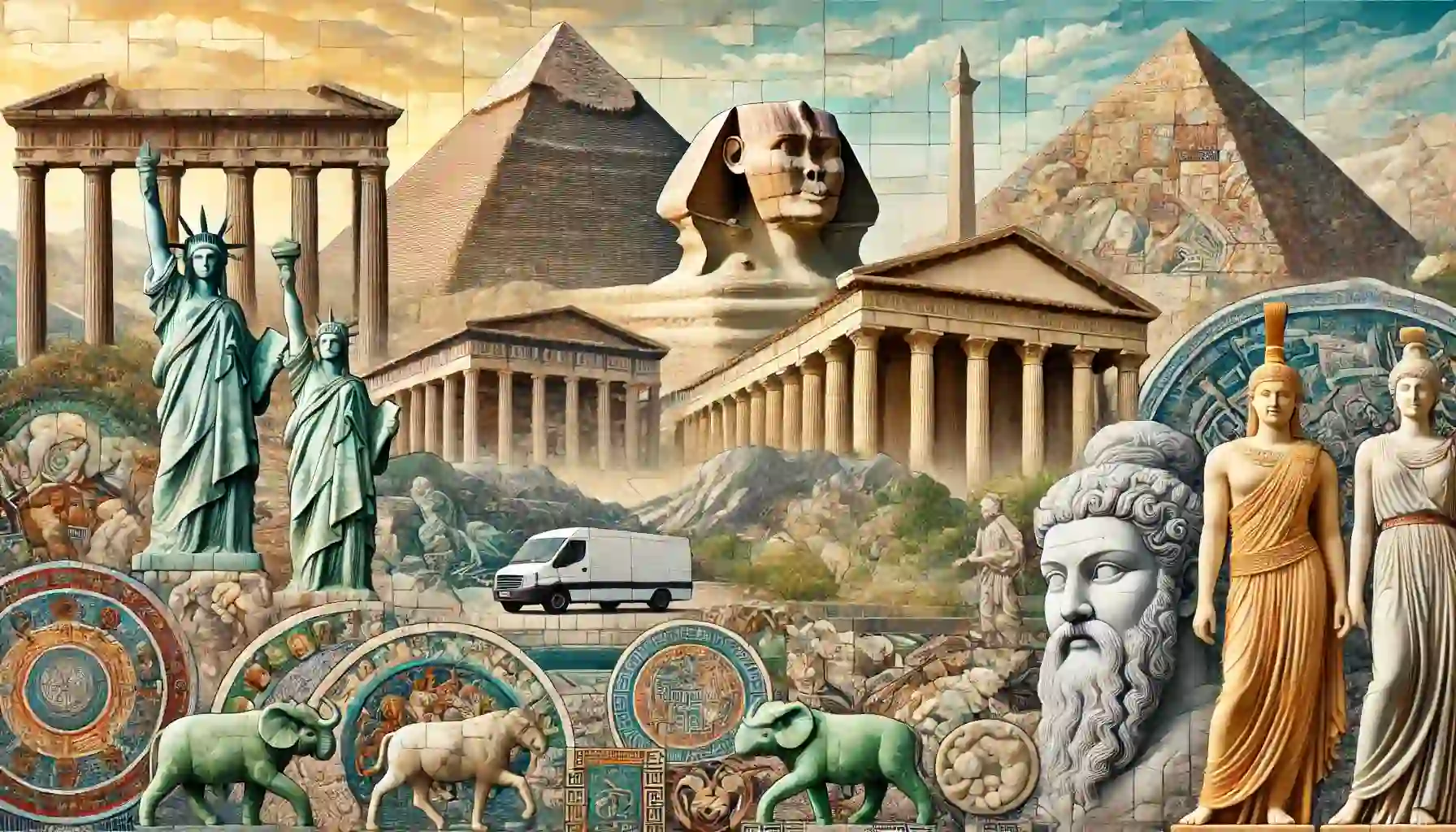heirAncient Artz encompasses the artistic creations of early civilizations with established writing systems. It distinguishes itself from prehistoric art, which lacks written records, and pre-Columbian art of the Americas. Originating from cultures like Egypt, Greece, and Mesopotamia, Ancient Artz reveals societal values and beliefs. This art includes grand structures, sculptures, and symbolic paintings, each showcasing a civilization’s worldview. Ancient Artz thus provides a unique lens into humanity’s early expression and understanding.
Significance of Ancient Artz:
Ancient Artz served as a powerful tool for cultural identity and religious communication in society. Civilizations used art to honor gods, record historical events, and represent social hierarchies. Temples, statues, and murals conveyed beliefs and expressed reverence through rich symbolism and artistry. Ancient Artz also documented daily life, providing future generations insights into each culture’s values. By studying these works, we uncover the influences that ancient civilizations imparted to later art movements.
The Evolution of Ancient Artz:
The evolution of Ancient Artz showcases humanity’s journey from simple cave paintings to complex sculptures. Early societies expressed themselves through basic forms, later advancing with monumental architectural achievements. As civilizations grew, their art reflected societal shifts, religious beliefs, and social hierarchies. These societies developed distinct artistic languages, making their cultures unique and memorable. Ancient Artz, therefore, tells the story of human advancement and creativity through various stages.
Key Civilizations in Ancient Artz:
| Civilization | Art Forms & Achievements | Key Techniques | Notable Legacy |
| Egypt | Hieroglyphics, monumental sculpture (pyramids, statues) | Stone carving, frescoes | Influence on architecture and symbolic art |
| Greece | Sculpture, pottery, frescoes | Bronze casting, marble carving, pottery | Foundations of Western art and philosophy |
| Rome | Mosaics, frescoes, sculpture | Mosaic work, stone carving, fresco painting | Legacy in architectural design and sculpture |
| Mesopotamia | Ziggurats, cylinder seals, relief sculptures | Stone and clay relief work, pottery | Early use of writing in art and architecture |
| China | Calligraphy, pottery, jade carving, silk painting | Ink on silk, porcelain, bronze casting | Influence on East Asian art and philosophy |
Ancient Egyptian Artz:
Ancient Egyptian art is known for its deep symbolism, stylized forms, and unique hieroglyphics. Egyptian art often displayed stiff, formal figures that conveyed religious reverence and societal roles. Symbolism played a significant role, with elements like the ankh and scarab representing life and rebirth. Artworks like the Pyramids of Giza, the Great Sphinx, and tomb paintings remain iconic representations. These pieces provide insight into Egyptian beliefs and their pursuit of immortality.
Greek and Roman Artz:
Greek Artz focused on naturalism, harmony, and the ideal human form, inspiring countless future generations. Their architecture is notable for its columns, seen in structures like the Parthenon. Their pottery depicted scenes of mythology, athleticism, and daily life, emphasizing balance. Roman Artz, in contrast, emphasized realism, capturing life’s imperfections in portraiture and sculptures. The Colosseum, Augustus of Prima Porta, and frescoes showcase Rome’s grandeur and innovation.
Mesopotamian Artz:
Mesopotamian Artz served significant political and religious purposes, conveying the power of rulers and gods. Reliefs and carvings adorned temples and palaces, often depicting warfare or divine scenes. Ziggurats, large step-like temples, symbolized the connection between the earth and the heavens. The Ishtar Gate, the Code of Hammurabi, and the Ziggurat of Ur reflect Mesopotamia’s artistic and architectural advances. This art form illustrates a civilization deeply connected to religious symbolism.
Ancient Chinese Artz:
Ancient Chinese Artz encompassed calligraphy, jade carving, and bronze casting, each highly valued within Chinese culture. Calligraphy evolved as an esteemed art form, representing harmony and self-discipline. Jade carvings symbolized virtue and were often buried with the deceased as protective amulets. Notable works include the Terracotta Army, intricate jade carvings, and calligraphy scrolls. These creations reflect China’s respect for balance, order, and ancestral reverence.
Other Civilizations in Ancient Artz:
Beyond Egypt, Greece, Rome, and China, other cultures enriched Ancient Artz with distinct contributions. Indian art portrayed spiritual figures and natural themes in stone carvings and paintings. Persian art highlighted grand palaces and exquisite metalwork, symbolizing their strength and sophistication. Art from Palestine displayed religious themes, reflecting its diverse cultural influences. These civilizations collectively contributed to the rich tapestry of Ancient Artz.
Techniques and Materials in Ancient Artz:

Common Materials Used in Ancient Artz:
Ancient Artz utilized a variety of materials, each offering durability and artistic flexibility. Stone, widely used in Egyptian and Mesopotamian art, was carved into intricate reliefs and statues. Clay served as the primary medium in Mesopotamian pottery and tablets, while jade was highly prized in Chinese art for its symbolic value. Egyptian artists worked with gold and papyrus to create highly detailed and symbolic works. Bronze, favored by Greek and Chinese artists, allowed for precision in casting sculptures. These materials reflect the diversity of ancient art techniques and the cultural significance attached to each.
Key Ancient Art Techniques:
- Stone Carving: Used extensively in Egypt, Mesopotamia, and Greece for creating statues and reliefs.
- Fresco Painting: Popular in ancient Rome and Greece, fresco painting involved applying pigments on wet plaster.
- Bronze Casting: Used by the Chinese and Greeks to make sculptures, tools, and ceremonial items.
- Mosaic Work: A technique in which small pieces of glass, stone, or ceramic tiles were used to create images, often seen in Roman and Byzantine art.
- Calligraphy: Developed particularly in China and Egypt, where writing was both functional and artistic.
Cultural Significance:
1. Religious and Mythological Themes:
Ancient Artz often served as a bridge between humans and the divine, depicting gods, heroes, and spiritual events. Egyptian art focused on religious figures like Ra and Osiris, ensuring a successful afterlife. Greek temples dedicated to gods like Zeus and Athena celebrated divine power through sculptures and paintings. In Mesopotamian art, depictions of gods such as Ishtar and Marduk adorned temples, asserting divine influence over the land. These religious representations highlight the essential role of art in ancient rituals and beliefs.
2. Symbolism in Ancient Artz:
Symbols in Ancient Artz reinforced cultural values and conveyed deeper meanings within each society. The Ankh, a symbol of life in Egypt, signified immortality and divine protection. Greek art prominently featured the laurel wreath, a symbol of honor and victory, awarded to champions. In China, the dragon symbolized strength and protection, often seen in imperial art. These symbols were integral to understanding the cultural and spiritual significance behind ancient artworks.
3. Artistic Reflection of Societal Structures:
Ancient Artz often depicted societal hierarchy, daily life, and cultural values, offering insights into social dynamics. In Egypt and Rome, royal portraits conveyed the power and divine status of rulers. Greek pottery depicted scenes of everyday life, from athletic events to domestic activities, reflecting their social order. Art served as a mirror to the values and structures that defined each civilization, illustrating the relationship between art, power, and society.
Preservation and Restoration of Ancient Artz:
Efforts to Preserve Ancient Artz:
Efforts to preserve Ancient Artz have evolved with advancements in technology and restoration techniques. Digital reconstruction allows for the virtual preservation of deteriorating artworks, especially sculptures, and architecture. Modern restoration practices involve using advanced materials to repair damage while maintaining the artwork’s authenticity. Scientists and conservators use non-invasive methods like 3D scanning to understand the condition of artifacts without causing harm. These innovations ensure that future generations can experience and study ancient artworks.
Challenges of Preservation:
Ancient Artz faces numerous challenges from both natural and human factors that threaten its survival. Erosion, caused by environmental elements like wind and water, can slowly wear away stone and murals. Urbanization often leads to the destruction of ancient sites, while tourism puts additional strain on fragile monuments. Human actions, such as looting or poorly executed restoration efforts, further endanger these treasures. Preserving ancient art requires addressing these complex challenges to safeguard it for the future.
Case Studies in Restoration:
Several notable examples showcase the restoration of ancient art and architecture. The Parthenon in Greece has undergone extensive restoration to repair damage caused by time, war, and pollution. Digital restoration projects, like those conducted for the tomb paintings in Egypt’s Valley of the Kings, allow for the virtual recreation of faded artworks. These cases highlight the importance of modern technology in both restoring and preserving ancient masterpieces.
Frequently Asked Questions:
What materials did ancient artists commonly use?
Ancient artists frequently used materials like stone, clay, wood, bronze, and gold to create their works. Egyptians favored limestone and sandstone for sculptures, while Greeks used marble for their iconic statues.
How did ancient art evolve?
Ancient art evolved as civilizations advanced, moving from simple forms like cave paintings to complex sculptures, frescoes, and architectural marvels. Artists began to experiment with realism and more detailed representations of the human form.
What are some iconic examples of ancient art from each major civilization?
Some iconic examples include the Egyptian pyramids, Greek sculptures like the Discobolus, and the Roman Colosseum. Mesopotamian art includes the Ishtar Gate, while China’s Terracotta Army showcases their mastery in sculpture.
How has ancient art influenced modern art?
Ancient Artz has heavily influenced modern art by inspiring techniques, styles, and themes. Greek and Roman ideals of beauty, proportion, and symmetry are central to Western art traditions. Additionally, symbolism from ancient art continues to appear in contemporary works.
What are the main challenges in preserving ancient art today?
The main challenges include environmental degradation, human impact from tourism and urbanization, and the difficulty of restoring fragile works without causing further damage. Preservation efforts require a balance between access and protection.
Conclusion:
Ancient Artz has profoundly shaped modern artistic expression and cultural values. The creative accomplishments of ancient civilizations continue to influence contemporary art, architecture, and design. From the principles of Greek naturalism to Egyptian symbolism, ancient art informs how we interpret the world today.
Studying and preserving Ancient Artz is essential for understanding human history and cultural development. These artworks provide invaluable insight into the beliefs, daily life, and achievements of past societies. By safeguarding them, we ensure that future generations can appreciate and learn from these timeless masterpieces.










